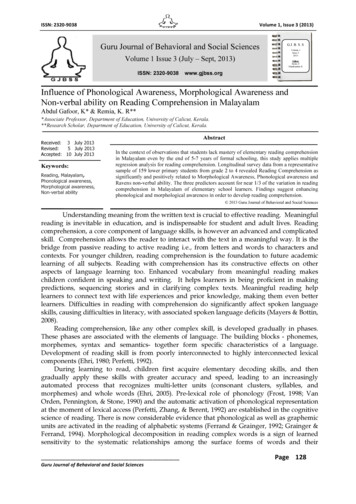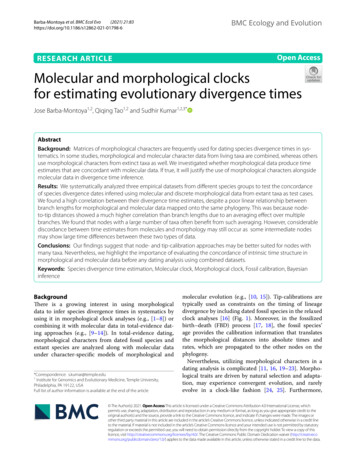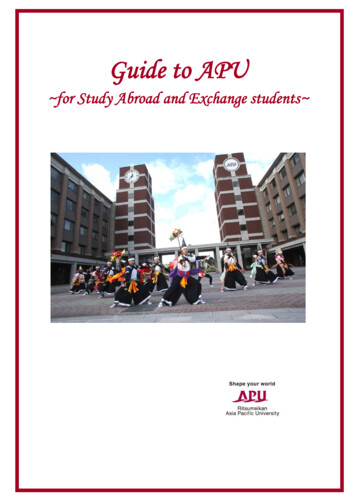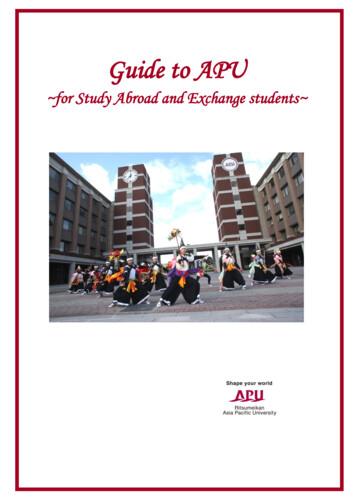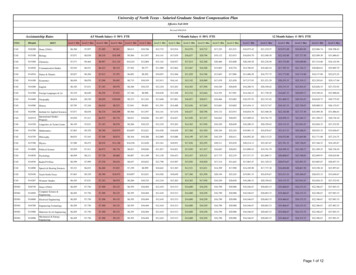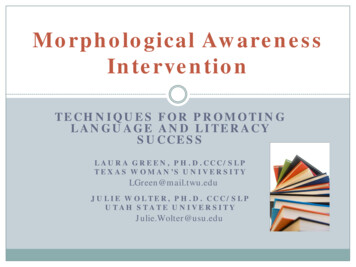
Transcription
Morphological AwarenessInterventionTEC HN I Q UES FOR PR OMOTI N GL A N G UA G E A N D L I TER A C YS UC C ES SLAURA GREEN, PH.D.CCC/SLPTEXAS WOMAN’S UNIVERSITYLGreen@mail.twu.eduJULIE WOLTER, PH.D. CCC/SLPUTAH STATE UNIVERSITYJulie.Wolter@usu.edu
CompoundingsidefirelawnbookspacecowGreen & Wolter (2011)walkfightermowershelfsuitboy
Word Part Combining(in blue)anti- (against)micro- (small)un- (not)re- (repeat)Green & Wolter (2011)(in green)(in red)-ped (to walk)-ology (study of)-act- (to do)-ion (state of being)-dict- (to say)-ness (state of being)-mot- (to move) -or (doer)
Morphological Awareness Morphological awareness can most simply be definedas “the study of word structure” (Carlisle, 2004) Involves the ability to manipulate and combinemorphemes Adding suffixes to base words - readers learn to seewords as the sum of these component parts - able toinfer the meaning and pronunciation of unfamiliar words(Green, 2009).Green & Wolter (2011)
Morphological Awareness:Impacts Language and ting(Bowers, Kirby, & Deacon, 2010; Carlisle, 1996; 2000; Carlisle 2004; Elbro & Arnback, 1996; Fowler & Liberman, 1995;Goodwin & Ahn, 2010; Reed, 2008; Singson, Mahoney, & Mann, 2000; Windsor, 2000)Green & Wolter (2011)
Morphology and Vocabulary: The Connection Children increase vocabulary by using themeanings of familiar base words and suffixes toinfer the meanings of unfamiliar derivatives. pigletlittle pigGreen & Wolter (2011)little -let owletlittle owl
Morphology and Vocabulary: Research Approximately 60% of new words acquired byschool-age children are morphologically complex(Anglin, 1993). Morphological awareness treatment resulted inability to generalize this strategy to infer meaning inunknown words (Bauman, Edwards, & Kameenui, 2003;Baumann, Edwards, Kameenui, & Olejnik, 2002).Green & Wolter (2011)
Morphology and Reading: The Connection Reading Comprehension DecodingMorphemeknowledge/spellings- ion, nutrition,conversationGreen & Wolter (2011)Morphemeknowledge“astronaut”“Ocean” “naut”Understandvocabularynaut travelerTextcomprehensionThe oceanaut was interested inknowing more about fish habitats.
Morphological Awareness and Literacy Researchers have found strong correlations betweenmorphological awareness and success in reading,writing and spelling (Apel & Lawrence, 2011; Carlisle, 2000;Binder & Borecki, 2007; Green, 2009; Jarmulowicz, Hay, Taran &Ethington, 2008; Kirby, Desrochers, Roth & Lai, 2008; McCutchen,Green & Abbott, 2008; Nagy et al., 2006; Schwiebert, Green &McCutchen, 2002; Wolter, Wood & D’zatko, 2009). Researchers have reported that knowledge ofmorphology is significantly related to reading andspelling abilities even in the elementary years (e.g.,Carlisle, 1995; Carlisle & Nomanbhoy,1993; Nunes, Bryant, &Bindman, 2006; Wolter, et al., 2009).Green & Wolter (2011)
Morphology and Writing: The ConnectionOur writingsystem ismorphologicallymeaning-based: Different morphemes withidentical pronunciations spelleddifferently (bare/bear) Morphemes with differentpronunciations in differentcontexts maintain a constantspelling (sign/signature).For example, consider the following spelling errors:Esere for easier; Carlls for careless; Produst for produced; Counten for countingGreen & Wolter (2011)
Morphology and Writing: Research Evidence suggests that children as early askindergarten and first grade are incorporatingtheir knowledge of base words into theirspellings (e.g., Treiman, Cassar, & Zukowski,1994;Treiman & Cassar,1996; Wolter Wood, D’zatko, 2009)and exhibit an emerging knowledge ofmorphological endings in words (Carlisle, 1996;Carlisle & Nomanbhoy, 1993; Wolter et al., 2009). Accuracy of use of morphological forms inwriting is predictive of reading and spellingperformance in third and fourth graders (Green,McCutchen & Schwiebert, 2001).Green & Wolter (2011)
Morphological Awareness Instruction Reed (2008) conducted a research synthesis on 7research studies and found strong treatment effectsfor morphological awareness interventions thattargeted reading development in an age ofacquisition pattern. Two recent meta-analyses revealed morphologicalawareness instruction to be beneficial for school agechildren in the areas of reading, vocabulary, andspelling (Bowers et al., 2010; Goodwin & Ahn, 2010)Green & Wolter (2011)
Morphological Awareness Instruction andChildren with Disabilities Goodwin & Ahn (2010) conducted a meta-analysis of17 studies and found that morphological awarenessinstruction was effective for children with reading,learning, or speech and language disabilities. Bowers et al. (2010) studied 22 research studies andfound that morphological awareness instructionresulted in increased benefits for children withliteracy deficits. Additionally, this instruction wasmore effective when combined with other literacyinstruction.Green & Wolter (2011)
Morphology, Phonology and Orthography:Connections for Readers and Writers Morphology-Phonology: Need to appreciate thatsome derivations involve sound changes (e.g.,magic-magician). Morphology-Orthography: Need to know theorthographic patterns onto which meaning ismapped, also recognizing that some derivationsinvolve spelling changes (e.g., five-fifth). Phonology-Orthography: Need to understand thatsounds map onto letters (alphabetic principle) inorder to decode and spell.Green & Wolter (2011)
Morphological Development of Typical StudentsPreschoolers:Have some ability to use suffixes andcompounding to coin new words.Second Graders:Can infer meanings of new words based onword structure.Between Grades 3 and 5:There is a massive increase in children’smorphological knowledge.Green & Wolter (2011)Beginning in 4th Grade: Knowledge of syntacticfunction of derivational suffixes (i.e. –nessindicates a noun) begins (Tyler & Nagy, 1989) andcontinues to develop through the school years.
Morphological Development of At-Risk StudentsIn written narratives, of 2nd and 3rdgraders with Learning Disabilities, therewere significantly fewer morphologicallycomplex words than their typical peersand their use of the forms is less accurate(Carlisle, 1996).Children with Learning Disabilitiesand have difficulty learningmorphological rules (Wiig, Semel, &Crouse, 1973).Green & Wolter (2011)
Children with Learning Disabilities tendto:Continue to useless matureforms (Windsor,2000; Curtis,Kutz, & Tallal,1992).Show poorercommand ofpast tenseinflections(Moran & Bryne,1977Green & Wolter (2011)Tend to makemorphemicerrors in writing(Rubin et al.,1991).
AssessmentGreen & Wolter (2011)
Morphological Awareness Assessment Likely will use non-standardized measures(Carlisle, 1996): Generation task: Observant: I need to for my class.Magic: David Copperfield is a goodRelational task: moth – motherSwim-swimming New Standardized TOLD -4 (inflections and derivations) New TOAL (derivations)Green & Wolter (2011)
Examples from the Derivational Suffix Test (Green,2004) Part AExample: farm: My uncle is a .1. ill: Maria worried about her .2. quick: Sheila had to work .3. nerve: I got .4. five: A line formed and Sue was .*5. swim: Kim wanted to improve her .6. victory: Marco’s soccer team was .** shift wordsGreen & Wolter (2011)
Treatment: Links to theClassroomGreen & Wolter (2011)
Treatment RationaleGreen & Wolter (2011)Instruction inchangingmeaning andhow morphologycan helpIncorporation ofall three literacycodes(phonological,orthographic, andmorphological)Repeated practicewith newlylearnedinformationApplication ofnewly-learnedskills in functionalreading andwriting contexts
Treatment Linked to StandardsTreatment goals can be linked to nationalor state academic standards andbenchmarksThese standards are in the areas of reading,writing, vocabulary and languageGreen & Wolter (2011)
K-12 StandardsSpeaking and Listening Inclusion of formal/informal talkLanguage Using standard English in formalwriting and speaking Determining word meanings and wordnuances Acquiring general academic anddomain-specific words and phrasesGreen & Wolter (2011)
K-12 Standards continued Reading Foundational Skills Print concepts (K 1)Phonological awareness (K 1)Phonics and word recognition (K 5)Fluency (K 5) Reading Comprehension Balance of literature and informational textsWriting Writing informative/explanatory texts Writing narrativesGreen & Wolter (2011)
Common Core Example: Language Vocabulary Acquisition and Use L.6.4. Determine or clarify the meaning of unknownand multiple-meaning words and phrases based ongrade 6 reading and content, choosing flexibly from arange of strategies. Use common, grade-appropriate Greek or Latin affixes androots as clues to the meaning of a word (e.g., audience,auditory, audible).Green & Wolter (2011)
Common and STATE STANDARDS Common Core Standards http://www.corestandards.org/the-standardsIPAD AP: EZ Common Core at the Ap. storeGreen & Wolter (2011)
Example IEP Goal The student will determine the meaning oftargeted grade-level academic words byidentifying their roots and affixes, explainingtheir meanings, and using them correctly in asentence with 80% accuracy across 2 of 3sessions.Taken fromTEKS: Grade 5 (2) Reading/Vocabulary Development. Students understand newvocabulary and use it when reading and writing. Students areexpected to: (A)determine the meaning of grade-level academic English wordsderived from Latin, Greek, or other linguistic roots and affixesGreen & Wolter (2011)
Treatment ImplementationGreen & Wolter (2011)
Treatment Where do we begin? What elements of morphology should weinclude? What kinds of activities can we utilize? How do we gather data?Green & Wolter (2011)
Concept Introduction Compounding activity: “firewalker” Harry Potter Words: “toothflossing stringmints” Decode “sleeplessness” by breaking it intomorphemes Begin targeting a pattern (inflectional orderivational) and provide multiple examples. “ed” means something happened in the past“-ful” means you are “full of” the base word“un-” means you are not it or not doing itGreen & Wolter (2011)
Green & Wolter (2011)
Concept Explanation: InflectionWe will learnabout wordsand word partsto help youlearn morewords andbecome a betterreader andspeller.Green & Wolter (2011)Some suffixeschange a word’snumber or tell whena verb happened oris happening (e.g.,plural “s” meansmore than one, “ed”means the actionhappened in thepast)These endingsare spelled thesame each timeyou use them,even thoughthey may sounddifferent (e.g.,cats, girls)
Concept Explanation: DerivationLearningabout wordsand wordparts to helpyou learnmore wordsand become abetter readerand speller.Green & Wolter (2011)Words can bebroken upinto partscalledmorphemes.‘Morphing’words meanschangingthem tochangemeaning.A base wordcan stand all byitself. It’s thepower of theword and tellsus what theword is about.A base wordmight be“read” or“heat”.We can add asuffix or prefixto make achange. So wecan change “read”to “readable.” Or,we can change“heat” to“preheat.”
Treatment Mission ActivitiesGreen & Wolter (2011)
Mission: Create/Find MeaningAffixes changeword meaning, so:Green & Wolter (2011)Reasoning byanalogy canincrease wordcomprehension ifaffix is understoodAffix knowledgecan increasedevelopment ofnew words
Audience Activity: Reasoning by AnalogyWhat is the meaning of the following words? centenarian definiendum fructuous pentarchy subjacentCreate derivations of the following nonsense verb:“ponk”Green & Wolter (2011)
Meaning Activity: “Mystery Word”See if you can use the clues to figure out the mystery wordsdescribed below. All of the words have a suffix that we’velearned and were somewhere in today’s lesson.Who am I? I work at a place where people deposit theirmoney and cash their checks. (banker)What am I? You could describe me with this word because Ialways tell things the way they really happened. I don’t lie.(truthful)What am I? You could describe me with this word because Iam good at creating things. (creative)Who am I? I am someone who always loves a really goodbook. (reader)Green & Wolter (2011)
Mission: Identify Base Word-AffixRelationshipsWe can sort out whichwords aremorphologically complexand which are notGreen & Wolter (2011)We can break up thewords into morphemesto make them easier todecode and comprehend
Relationship Activity: “Word Detective”Find the base word and the suffix in thefollowing words. Underline the base andcircle the suffix. Then, read the word andtalk about what it veGreen & Wolter (2011)painterjoyfulcreativecarefuldrummeractive
Relationship Activity: All in the Family(Cunningham, 1998; adapted by Wolter, 2005, Wasowicz, Apel, Masterson & Whitney,2004)Family Members Can: Look or Sound Alike and Be Related swim – swimming slip – slipped Look or Sound Different and Be Related divide – division explode -explosion magic – magicianOR Look or Sound Alike but NOT Be Related (friends) car-carrotluck-cluckAre teacher and teach related?Are mother and moth related?Are clinician and clinic related?Are brother and broth related?Green & Wolter (2011)
Morphology Instruction (lesson adapted from Cunningham, 1998;Wolter, 2005) INSERT “All in the Family” sample video here
Morphology Instruction: Sample morphologyword sort
Relationship Activity: “Match-Up”Read the base words in the left hand column. Then, drawa line from the base word in the left hand column to anappropriate suffix from the right hand column. Say thewords out loud and talk about what they mean.”bankfaithdefensepaintGreen & Wolter (2011)iveererful
Mission: Identify Spelling PatternsMorphemes tendto haveconsistentspellingsGreen & Wolter (2011)Rules govern theaddition ofsuffixesDerived formscan help identifysilent letters inbase words
Spelling Activity: Sort It!* Sort the following pairs of words into two groups:Tape/taping Hop/hoppingTap/tappingHope/hoping Slop/slopping Slope/slopingGroup 1Group 2* What is the rule for Group 1? What is the rule for Group 2?Green & Wolter (2011)
Sample Video – Small-Group Past-tense“ed”Green & Wolter (2011)
Spelling Activity: Sort It and Spell It Sort it out: Given the following words, sort theminto two leediblemanageablefashionablehorrible Spelling Strategy for adding –able or –ible: If youcan delete the ending and the remaining base wordis a real word, then the suffix is most likely –ableGreen & Wolter (2011)
Mission: Develop Syntactic AwarenessDerivationalaffixes changewords’ parts ofspeech so:Green & Wolter (2011)Can gain- syntactic flexibility- increased sentencecomprehension- increased writtenexpression
Syntactic Activity : Sentence Completion Change the word to fill-in-the-blank andmake grammatically correct sentences.The was very talented. (paint)That is a book. (read)He has a college . (educate)The sketched a picture. (art)Green & Wolter (2011)
Syntactic Activity: Morphing WordsGiven a base word, “morph” the word into as manyword forms as possible using previously taughtprefixes and suffixes. Label each word according toit’s part of ilityGreen & Wolter edApplicableInapplicableAdverb:Heatedly
Audience Activity: Morphing WordsGiven a base word, “morph” the word into as manyword forms as possible using previously taughtprefixes and suffixes. Label each word according toits part of speech.WordElectricGreen & Wolter (2011)Noun:Verb:Adjective:Adverb:
Syntactic Activity: Build the Word/Use theWordAdd –y to the words below. Then put those words incomplete sentences that make sense. The first one is donefor you.Base Word: New Word: Sentence:1.2.3.4.powder: powdery: The new snow was very powderypuff: :grass: :sweat: :Green & Wolter (2011)
Mission: Increase Phonemic AwarenessCan be addressed byexamining derivationalchanges in wordsGreen & Wolter (2011)“Shift words” undergo aphonemic change (andsometimes a spellingchange) when a suffix isadded
Phonemic Awareness Activity: Changeor No Change? act-actor flame-flammable attain-attainable tickle-ticklish magic-magician please-pleasantGreen & Wolter (2011)
Mission: Apply in Functional ContextsShow applicabilityin reading andwriting tasksGreen & Wolter (2011)Use curricularmaterials whenpossible
Morphological Awareness Instruction integratedin vocabulary/writing class lesson INSERT VIDEO HERE
Sample Writings
Sample Writings
Application Activity: Morphology in 7th GradeScienceFind the morphed words in the paragraph. Talk about whatthey mean and how you could figure that out:Continental DriftIn 1910, a young German scientist named Alfred Wegener (vayguh nur) became curious about the relationship of the continents. Hehypothesized that Earth’s continents had moved! Wegener’s hypothesiswas that all the continents were once joined together in a singlelandmass and have since drifted apart. Wegener’s idea that thecontinents slowly moved over Earth’s surface became known ascontinental drift.Wegener attempted to explain how continental drift took place.He suggested that the continents plowed across the ocean floors.Unfortunately, Wegener could not provide a satisfactory explanation forthe force that pushes or pulls the continents. Because Wegener could notidentify the cause of continental drift, most geologists rejected his idea. Pearson EducationGreen & Wolter (2011)
Application Example: Reading ComprehensionLook at the passage below and underline the words with the –or, able,and -ation suffixes. Then, answer the questions.Sarah had a wild imagination. She liked to daydream.Sometimes she was a brave warrior. Other times she was asailor on a boat in the ocean. There was always thetemptation to daydream at school. Her teacher said this wasnot acceptable. He wanted Sarah to pay attention in class.Sarah did want to learn. She was agreeable and tried tolisten carefully to class information. Her teacher helped heruse her imagination in different ways. He let Sarah be theillustrator of class stories. He let her be a lead actor in theschool play. Sarah had to do a lot of preparation for thesejobs. But she thought it was fun. And, she had theadmiration of her friends. So, she enjoyed daydreaming athome and trying new things at school.Green & Wolter (2011)
Comprehension QuestionsWhat did Sarah daydream about?2. Why was it not acceptable to daydreamat school?3. How did Sarah use her imagination indifferent ways?4. Why did she have to do a lot ofpreparation?1.Green & Wolter (2011)
“Applicization” Think of a student on your caseload for whom thistype of intervention would be appropriate. How might you determine baseline performance? How would you introduce the concept intherapy? What type of activities would you include? How would you measure progress?Green & Wolter (2011)
Intervention Resources Ready, Set, Grammar, Scissors, Glue and Grammar Too, No Glamour Grammar, 100% Reading: Decoding and WordRecognition Linguisystems 1-800-PRO-IDEAWords: Integrated Decoding and Spelling Instruction ProEd 1-800-897-3202Words Their Way: Word Study for Phonics, Vocabulary, andSpelling Instruction Pearson Education, 1-800-223-1360Language! Sopris West (Supplement: Roots!)Month by Month Phonics for the Upper Grades by PatriciaCunningham (available in teachers’ supply stores)Vocabulary from Classical Roots Educators PublishingServicesGreen & Wolter (2011)
References Anglin, J. (1993). Vocabulary development: A morphological analysis. Monographs ofthe Society of Research in Child Development, 58, (10, Serial No. 238).Apel, K. & Lawrence, J. (2011). Contributions of morphological awareness skills to wordlevel reading and speiing in first-grade children with and without speech sound disorder.Journal of Speech Language and Hearing research, 54, 1312-1327.Apel, K., & Masterson, J. J. (2001). Theory guided spelling assessment and intervention:A case study. Language, Speech, and Hearing Services in the Schools, 32(3), 182-195.Bear, D.R., Invernizzi, M., Templeton, S. & Johnson, F. (2004). Words their Way (3rded.). Upper Saddle River, N.J.: Merrill.Bear, D., & Templeton, S. (1998). Explorations in developmental spelling: Foundationsfor learning and teaching phonics, spelling, and vocabulary. Reading Teacher, 52(3),222-243.Berninger, V.W., Vermeulen, K., Abbott, R.D., McCutchen, D., Cotton, S., Cude, J., Dorn,S., & Sharon, T. (2003a). Comparison of three approaches to supplementary readinginstruction for low-achieving second-grade readers. Language, Speech, and HearingServices in the Schools, 34, 101-116.Berninger, V., Nagy, W., Carlisle, J., Thomson, J., Hoffer, D., Abbott, S. & Johnson, C.(2003b). Effective treatment for dyslexics in grades 4 to 6:Behavioral and brainevidence. In B. Foorman (Ed.), Preventing and treating reading disability: Bringingscience to scale (pp. 382-417). Timonium, MD:York Press.Binder, K. & Borecki, C. (2007). The use of phonological, orthographic, andcontextualinformation during reading: a comparison of adults who are learning to readand skilledadult readers. Reading and Writing, 21, 843-858.Bowers, P.N., Kirby, J.R., Deacon, H.S. (2010). The effects of morphological instructionon literacy skills: A systematic review of the literature. Review of Educational Research,80, 144-179.
References Bruner, J. (1990). Acts of meaning. Cambridge, MA: Harvard University Press. Carlisle, J. F. (1996). An exploratory study of morphological errors in children’s written stories. Reading and Writing: An Interdisciplinary Journal, 8, 61-72.Carlisle, J. F. (2000). Awareness of the structure and meaning ofmorphologically complex words: Impact on reading. Reading and Writing: AnInterdisciplinary Journal,12,169-190.Carlisle, J. F. (2004). Morphological processes that influence learning to read.In C. A. Stone, E. R. Silliman, B. J. Ehren, & K. Apel (Eds.), Handbook oflanguage and literacy. NY: Guilford Press.Carlisle, J. F., & Nomanbhoy, D. M. (1993). Phonological and morphologicalawareness in first graders. Applied Psycholinguistics, 14, 177-195.Baumann, J.F., Edwards, E.C., Font, G., Tereshinski, C.A., Kameenui, E.J, &Olejnik, S. (2002).Teaching morphemic and contextual analysis to fifth-gradestudents. Reading ResearchQuarterly, 37, 150-176.Baumann, J.F., Edwards, E.C., & Kame’enue, E.J. (2003). Vocabulary tricks:Effects of instruction in morphology and context on fifth grade students’ abilityto derive and infer word meanings. American Educational Research Journal,40, 447-494.Green & Wolter (2011)
References Elbro, C., & Arnbak, E. (1996). The role of morpheme recognition and morphological awareness in dyslexia. Annals of Dyslexia, 46, 209-240.Fowler, A.E., & Liberman, I.Y. (1995). The role of phonology and orthographyin morphological awareness. In L. B. Feldman (Ed.), Morphological aspects oflanguage processing (pp. 157-188). Hillsdale, NJ: Erlbaum.Green, L. (2009). Morphology and literacy: Getting our heads in the game.Language, Speech, and Hearing Services in the schools, 40, 283-285.Goodwin, A.P. & Ahn, S. (2010). Annals of Dyslexia, 60, 183-208.Hurry, J., Nunes, T., Bryant, P., Pretzlik, U., Parker, M., Curno, T., andMidgely, L. (2005). Transforming research on morphology into teacherpractice. Research Papers in Education, 20(2), 187-206.Jarmulowicz, L., Hay, S.E., Taran, V.L. & Ethington, C.A. (2008). Fittingderivational morphophonology into a developmental model of reading.Reading and Writing, 21, 275- 297.Johnston , F. Bear, D.R., & Invernizzi, M., (2004). Words their Way: WordSorts for Derivational Relations Spellers. Upper Saddle River, N.J.: Merrill.Johnston , F. Bear, D.R., & Invernizzi, M., & Templeton (2004). Words theirWay: Word Sorts for Syllables and Affix Spellers. Upper Saddle River, N.J.:Merrill.
References Kirby, J.R., Desrochers, A., Roth, L. & Lai, S.S.V. (2008). Longitudinal predictors of word reading development. Canadian Psychology, 49, 103-110.Kirk, C. & Gillon, G.T. (2009). Integrated morphological awarenessintervention as a tool for improving literacy. Language, Speech, And HearingServices in Schools. 40, 341-351.Moats, L. (1994). The missing foundation in teacher education: Knowledge ofthe structure of spoken and written language. Annals of Dyslexia, 44, 81-102.Moats, L. (2000). Speech to print: Language essentials for teachers.Baltimore: Brookes.Nagy, W., Berninger, V.W., Abbott, R. (2006). Contributions of morphologybeyond phonology to literacy outcomes of upper elementary and middle-schoolstudents. Journal of Educational Psychology, 98 (1), 134-147.Nagy, W., Berninger, V.W., Abbott, R., Vaughan, K., & Vermeulen, K. (2003).Relationship of morphology and other language skills to literacy skills in at-risksecond-grade readers and at-risk fourth-grade writers. Journal of EducationalPsychology, 95(4), 730-742.
References Nunes, T., Bryant, P. & Olsson, J. (2003). Learning morphological and phonological rules: An intervention study. Scientific Studies in Reading, 7(3), 289307.Nagy, W., Berninger, V.W. & Abbott, R.D. (2006). Contributions of morphologybeyondphonology to literacy outcomes of upper elementary and middle-schoolstudents. Journal of Educational Psychology, 98, 134-147.McCutchen, D., Green, L. & Abbott, R.D. (2008). Children’s morphologicalknowledge: links to literacy. Reading Psychology, 29, 289-314.Reed, D.K. (2008). Synthesis of morphology interventions and effects on readingoutcomes for students in grades K-12. Learning Disabilities Research andPractice, 23, 36-49.Schwiebert, C., Green, L. & McCutchen, D. (2002). The contribution ofmorphology to reading and spelling. U.S. Department of Health and HumanServices, National Institute of Health , National Institute of Child Health andHuman Development, (NIH Publication No.50HD33812). Retrieved from ERICdatabase. (ED465986).Green & Wolter (2011)
References Treiman, R., & Cassar, M. (1996). Effects of morphology on children’s spelling of final consonant clusters. Journal of Experimental Child Psychology, 63, 141-170.Treiman, R., Cassar, M., & Zukowski, A. (1994). What types of linguisticinformation do children use in spelling? The case of flaps. Child Development, 65,1318-1337.Wolter, J.A. (2009). A Systematic Research Review of Word Study TreatmentPractices for the Speech-Language Pathologist. Evidence-Based Practice Briefs, 4(2)1-9.Wolter, J.A. (2007). Morphological Awareness Intervention: Considerations forEvidence-Based Practice. Perspectives on Language Learning and Education,14(1), 6-8. Edited/Peer-Reviewed.Wolter, J.A. (2005). Summary of special interest division 1 student research grant:A multiple linguistic approach to literacy remediation. Perspectives on LanguageLearning and Education, 12(3), 22-25.Wolter, J.A., & Hanson, M. (2007, November). Linguistic Factors InfluencingMorphological Awareness Measures. Poster session presented at the annualconvention of the American Speech-Language-Hearing Association, Boston, MA.Wolter, J.A., Wood, A., & D’Zatko, K. (2009). The influence of morphologicalawareness on first-grade children’s literacy development. Language, Speech, andHearing Services in the Schools, 40(3), 1-13.
Green & Wolter (2011)
techniques for promoting language and literacy success. laura green, ph.d.ccc/slp. texas woman's university. julie wolter , ph.d. ccc/slp. utah state university
